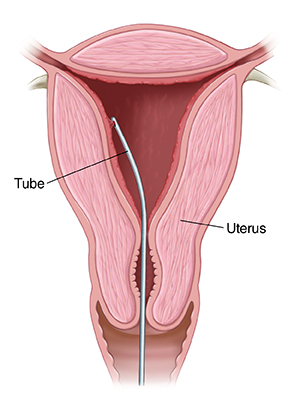Endometrial Biopsy
Endometrial biopsy is a procedure used to study the lining of the uterus. The lining of the uterus is also called the endometrium. The biopsy is usually done in your health care provider’s office. During the biopsy, small tissue samples are taken from inside the uterus. These are then sent to a lab for study. If any problems are found, you and your provider will discuss treatment choices. The biopsy usually takes only a few minutes, and you can often go back to your normal routine as soon as the procedure is over.
Reasons for the procedure
Endometrial biopsy may help pinpoint the cause of certain problems. These include:
-
Abnormal Pap test results.
-
Bleeding after menopause.
-
Bleeding linked to hormone therapy.
-
Having certain types of cancer.
-
Heavy or irregular menstrual periods.
-
Prolonged bleeding.
-
Trouble getting pregnant (fertility problems).
-
Damage to the uterine wall (very rare).
What are the risks?
Problems with endometrial biopsy are rare, but can include:
Getting ready for the procedure
Your health care provider will ask about your health and any medicines you take, like blood thinners. Before your biopsy, you may have tests to make sure you’re not pregnant or have an infection. You may also be asked to sign a consent form. You should do the following 1 to 2 days before the biopsy:
During the biopsy
During the biopsy, you will likely experience the following:
-
You will be asked to lie on an exam table with your knees bent, just as you do for a Pap test.
-
You may have a brief pelvic exam. An instrument called a speculum is then inserted into the vagina to hold it open.
-
An antiseptic solution may be applied to the cervix. The cervix may also be numbed with an anesthetic or dilated to widen the opening.
-
A small tube is passed through the cervix into the uterus.
-
It is normal to feel some cramping when the tube is inserted. But tell your health care provider if you have severe cramping or are very uncomfortable.
-
Using mild suction, samples are taken from the uterine lining. You may feel pinching or additional cramping when this is done.
-
The tube and speculum are then removed, and the samples are sent to a lab for study.

After the procedure
After the procedure, you may experience the following:
-
If you feel lightheaded or dizzy, you can rest on the table until you’re ready to get dressed.
-
For a few hours, you may feel some mild cramping. This can usually be relieved with over-the-counter pain medicines.
-
You may have some bleeding for a few days. Use pads instead of tampons.
-
Don’t douche or use any vaginal medicines unless your health care provider says it’s okay.
-
Ask your provider when it’s okay to have sex again.
Follow-up care
It will take about a week for the biopsy results to come back from the lab. Then you and your health care provider can discuss the results. These may show that no treatment is needed. Or you may be scheduled for a follow-up appointment and more tests. If your biopsy was done for fertility problems, be sure to record the day when your next period begins.
When to contact your doctor
Contact your health care provider if any of the following occur:
-
Fever of 100.4°F (38°C) or higher, or as directed by your provider
-
Foul-smelling or unusual vaginal discharge
-
Heavy bleeding (soaking more than 1 pad an hour for 2 hours)
-
Severe cramping or increasing pain
Online Medical Reviewer:
Daphne Pierce-Smith RN MSN
Online Medical Reviewer:
Rajadurai Samnishanth Researcher
Online Medical Reviewer:
Raymond Turley Jr PA-C
Date Last Reviewed:
3/1/2025
© 2000-2025 The StayWell Company, LLC. All rights reserved. This information is not intended as a substitute for professional medical care. Always follow your healthcare professional's instructions.